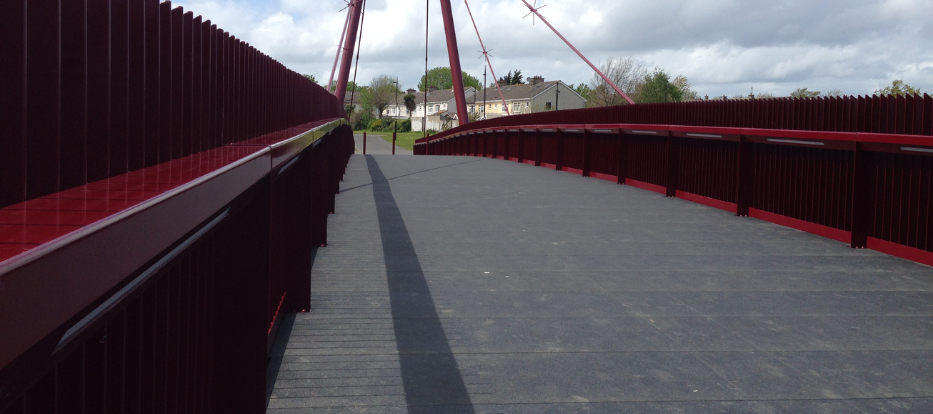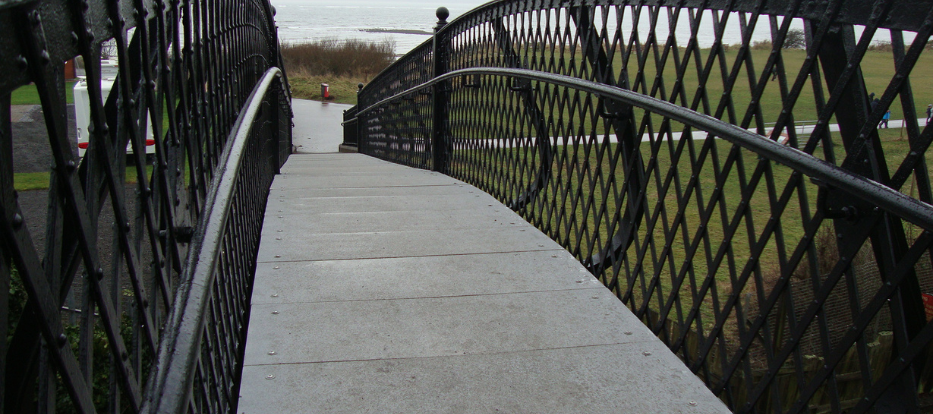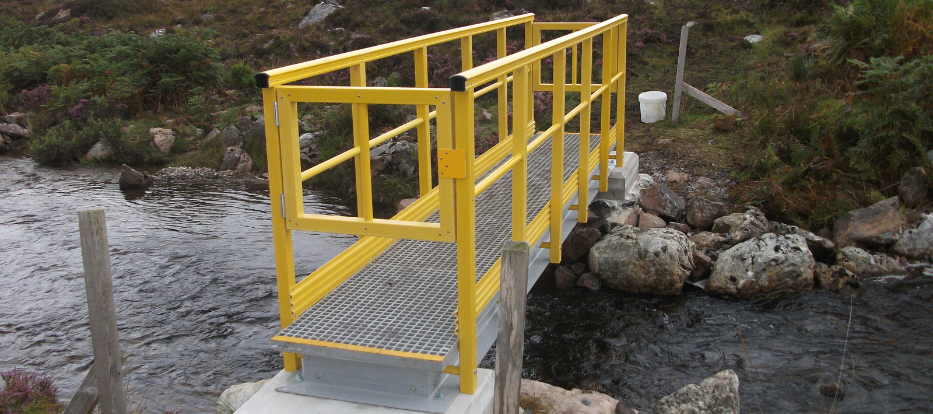Bridging the Gap with Innovation: The Advantages of GRP for Pedestrian Bridges
In the realm of civil engineering, pedestrian bridges play a crucial role in fostering connectivity and ensuring the safety of walkers and cyclists within urban environments. However, traditional materials like steel and concrete often present challenges – they can be cumbersome to install, expensive to maintain, and lack aesthetic appeal.
This is where Glass Reinforced Plastic (GRP) emerges as a transformative solution. This composite material offers a lighter, stronger, and more sustainable approach to pedestrian bridge flooring and construction, revolutionising the industry.
Safety is also vastly enhanced with Relinea GRP open mesh or solid top grating flooring. The integral grit finish offers the world’s highest slip resistance for a walk-on surface. The anti-slip grit does not chip or peel away from the grating and does not compromise the slip resistance. The embedded grit finish provides a steadier grip underfoot in wet, icy, or greasy conditions – ideal for wet, icy or oily conditions and outdoor use.
Unveiling the GRP Advantage: Efficiency Through Lightweight Design
GRP possesses an exceptional strength-to-weight ratio. Imagine a bridge boasting immense strength yet significantly lighter than its steel or concrete counterparts. This translates to a multitude of benefits:
- Streamlined Installation: Due to the manageable nature of GRP components, installation becomes a swift and efficient process, requiring minimal reliance on heavy machinery. This minimizes disruption to surrounding areas, ensuring a faster project turnaround.
- Reduced Foundation Requirements: The lower weight of GRP bridges can often obviate the need for intricate and expensive foundations, leading to substantial cost savings.
- Accessibility in Remote Locations: For bridges in geographically challenging areas, GRP’s lightweight nature facilitates easier transportation and even helicopter installation. This eliminates the need for heavy equipment, allowing for bridge construction in previously inaccessible locations.
Built to Endure: Unwavering Durability
GRP exhibits exceptional resistance to the very elements that can significantly deteriorate traditional bridges:
- Superior Corrosion Resistance: Unlike steel, GRP is immune to rust and degradation, ensuring minimal maintenance and a significantly extended bridge lifespan. Your GRP bridge will retain its aesthetic appeal for decades to come.
- Impervious to Environmental Factors: Rain, snow, and UV rays pose no threat to GRP. The bridge will stand strong throughout all seasons, requiring minimal upkeep to maintain its structural integrity.
- Exceptional Impact Resistance: GRP’s composite structure makes it highly resistant to accidental impacts and shocks, providing a safe passage for pedestrians even in high-traffic areas.
Beyond Durability: A Multitude of Advantages
The benefits of GRP extend far beyond its impressive durability:
- Reduced Maintenance Costs: GRP’s inherent resistance to corrosion and weather translates to minimal maintenance requirements compared to traditional materials. This translates to significant cost savings over the lifecycle of the bridge, freeing up valuable resources for other infrastructure projects.
- Design Flexibility for Inspired Bridges: GRP is a versatile material that can be moulded into a wide array of shapes and sizes. This allows for the creation of aesthetically pleasing and innovative bridge designs that seamlessly integrate with their surroundings. Imagine a bridge that transcends functionality and becomes a captivating landmark within your cityscape.
- A Sustainable Choice for the Future: GRP is often partially composed of recycled materials, and its lower manufacturing footprint makes it a more environmentally friendly option compared to traditional materials. With a growing focus on sustainability, GRP is the clear choice for building bridges that are kind to the planet.
- Cost-Efficiency Redefined: While innovation often comes at a premium, GRP defies conventional wisdom by offering cost-effective solutions without compromising quality or performance. Its lightweight nature translates to lower transportation and installation costs. Moreover, the ease of fabrication and versatility in design reduce construction time, optimizing project timelines and enhancing overall cost-efficiency.
Find out more about the benefits of GRP here.
Building a Brighter Future with GRP
GRP presents a compelling and innovative approach to constructing pedestrian bridges. From its efficient installation and lower maintenance costs to its unparalleled durability, design flexibility, and sustainability, GRP is the ideal choice for creating strong, sustainable, and aesthetically pleasing pedestrian bridges that elevate your community. So, the next time you embark on a bridge construction project, consider the advantages of GRP – lighter, stronger, and the future of pedestrian bridges.
——————————————————————————————————————————————————————-
Download our sustainability report to view: Environmental impact and embodied energy: Case study – Noorland footbridge, the Netherlands. GRP SUSTAINABILITY REPORT 2023
This case study details the how the replacement of a corroded steel footbridge, consisting of two 13.5m spans was required in Noordland inner harbour in the Netherlands. The location experiences severe weather conditions and high chloride levels. The client demanded a bridge solution that offered the most ecological benefits.
Talk to the experts:
With over 18 year experience in working with GRP, our team has a deep understanding of our customers challenges, and the expertise and specialist knowledge to design bespoke GRP solutions.
Call us today on 02894470010, email info@relinea.com or fill in our contact form and we’ll get back to you.







